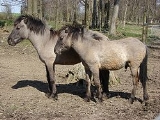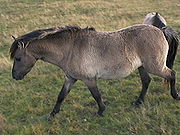
Heck horse
Encyclopedia

Horse breed
Horse breed is a broad term with no clear consensus as to definition, but most commonly refers to selectively bred populations of domesticated horses, often with pedigrees recorded in a breed registry. However, the term is sometimes used in a very broad sense to define landrace animals, or...
that resembles the extinct
Extinction
In biology and ecology, extinction is the end of an organism or of a group of organisms , normally a species. The moment of extinction is generally considered to be the death of the last individual of the species, although the capacity to breed and recover may have been lost before this point...
wild equine, the Tarpan
Tarpan
Tarpan is an extinct subspecies of wild horse. The last individual of this subspecies died in captivity in Russia in 1909....
, (Equus ferus ferus). The breed was created by the German
Germans
The Germans are a Germanic ethnic group native to Central Europe. The English term Germans has referred to the German-speaking population of the Holy Roman Empire since the Late Middle Ages....
zoologist brothers Heinz Heck
Heinz Heck
Heinz Heck was a German biologist and director of zoo in Munich . Heck worked on the breeding back projects of the Heck Horse, which strove to recreate the Tarpan , and the Heck Cattle, which was to recreate the aurochs, both of which...
and Lutz Heck
Lutz Heck
Ludwig George Heinrich Heck, called Lutz Heck was a German zoologist, animal researcher, an animal book author and director of the large zoo in the German capital city .Together with his brother Heinz Heck, also a zoologist and director of the largest zoological garden in southern...
, director of the Berlin Zoo, at the Tierpark Hellabrunn
Tierpark Hellabrunn
Hellabrunn Zoo is a zoological garden in the Bavarian capital of Munich. The zoo is situated on the right bank of the river Isar, in the southern part of Munich near the quarter of Thalkirchen...
(Munich
Munich
Munich The city's motto is "" . Before 2006, it was "Weltstadt mit Herz" . Its native name, , is derived from the Old High German Munichen, meaning "by the monks' place". The city's name derives from the monks of the Benedictine order who founded the city; hence the monk depicted on the city's coat...
Zoo) in Germany in their attempt to breed back
Breeding back
Breeding back can be described as either a natural or a human attempt to assemble or re-assemble the genes of an extinct species, subspecies or domesticated breed, which may still be present in the larger gene pool of the overall species or those of multiple interbreedable species.Breeding back is...
the tarpan. The first foal born from the program was a colt
Colt (horse)
A colt is a young male horse, under the age of four. The term "colt" is often confused with foal, which refers to a horse of either sex under one year of age....
born on May 22, 1933 at the Tierpark Hellabrunn.
History
The Hecks believed that they could recreate the extinct tarpan subspecies by back breedingBreeding back
Breeding back can be described as either a natural or a human attempt to assemble or re-assemble the genes of an extinct species, subspecies or domesticated breed, which may still be present in the larger gene pool of the overall species or those of multiple interbreedable species.Breeding back is...
living descendants. They believed that they could combine and rearrange the genetic material from these living descendants into a recreation of the extinct horse.
The Heck brothers bred together several European small horse and pony
Pony
A pony is a small horse . Depending on context, a pony may be a horse that is under an approximate or exact height at the withers, or a small horse with a specific conformation and temperament. There are many different breeds...
breeds hypothesized to be descended from the tarpan. They used mares of the Konik
Konik
The Konik or Polish primitive horse is a small horse, a kind of semi-feral horse, originating in Poland. The Polish word konik is the diminutive of koń, the Polish word for "horse" . However, the name "konik" or "Polish konik" is used to refer to certain specific breeds...
, Icelandic horse
Icelandic horse
The Icelandic horse is a breed of horse developed in Iceland. Although the horses are small, at times pony-sized, most registries for the Icelandic refer to it as a horse. Icelandic horses are long-lived and hardy. In their native country they have few diseases; Icelandic law prevents horses from...
, and Gotland
Gotland Pony
-External links:**...
breeds. These mares were bred to stallions of a wild horse type known as Przewalski's horse
Przewalski's Horse
Przewalski's Horse or Dzungarian Horse, is a rare and endangered subspecies of wild horse native to the steppes of central Asia, specifically China and Mongolia.At one time extinct in the wild, it has been reintroduced to its native habitat in Mongolia at the Khustain Nuruu...
. The Hecks believed that the wild Przewalski blood would help to draw out the wild characteristics that they felt lay dormant in the domesticated pony breed mares.
The first Heck horse, a stallion
Stallion
A Stallion is a male horse.Stallion may also refer to:* Stallion , an American pop rock group* Stallion , a figure in the Gobot toyline* Stallion , a character in the console role-playing game series...
named Duke, was exported to the United States in 1954. He was imported by the Chicago Zoological Park in Illinois, followed by two mares in 1955. In 1962, a third mare was imported by the Fort Worth Zoological Park in Texas. All four horses came from the Munich Zoo and all Heck horses in the United States trace back to these animals. There are now several private breeders in the United States who use their horses for riding and light driving. In the early 1960s, the North American Tarpan Association was founded by Heck horse enthusiasts to promote the breed.
Several breeders have crossed the Heck horse with other breeds to get a larger horse with some of the primitive characteristics. Breeds that are commonly crossed with the Heck horse are the Welsh pony
Welsh Pony
The Welsh Pony and Cob are closely related horse breeds including both pony and cob types, which originated in Wales in the United Kingdom...
and Arabian horse
Arabian horse
The Arabian or Arab horse is a breed of horse that originated on the Arabian Peninsula. With a distinctive head shape and high tail carriage, the Arabian is one of the most easily recognizable horse breeds in the world. It is also one of the oldest breeds, with archaeological evidence of horses...
, and a new breed of pony, called the Canadian rustic pony
Canadian rustic pony
The Canadian Rustic Pony is a breed of pony that originated in Canada, particularly Saskatchewan and Manitoba. The pony is the result of a crossing between the Heck horse and Welsh pony-Arabian horse crosses.-History:...
, has been developed from these three breeds. In Europe, many breeders cross Heck horses with Thoroughbred
Thoroughbred
The Thoroughbred is a horse breed best known for its use in horse racing. Although the word thoroughbred is sometimes used to refer to any breed of purebred horse, it technically refers only to the Thoroughbred breed...
s to produce hunter
Field hunter
A field hunter, or a fox hunter, is a type of horse used in the hunt field for fox hunting. It may be of any breed, but should possess stamina, a level head, and bravery. The horse should have a safe jump, so as not to get caught on any of the solid obstacles found in the hunt field...
s.
Breed characteristics
Heck horses are dunDun gene
The dun gene is a dilution gene that affects both red and black pigments in the coat color of a horse. The dun gene has the ability to affect the appearance of all black, bay, or chestnut -based horses to some degree by lightening the base body coat and suppressing the underlying base color to the...
or grullo
Grullo
Grullo is a color of horses in the dun family, characterized by tan-gray or mouse-colored hairs on the body, often with shoulder and dorsal stripes and black barring on the lower legs. In this coloration each individual hair is mouse-colored, unlike a roan which is composed of a mixture of dark and...
(a dun variant) in color, with no white markings. The breed has primitive markings
Primitive markings
Primitive markings among domestic horses are a group of hair coat markings and qualities associated with primitive breeds, and the dun coat color family in particular. All dun horses possess at least the dorsal stripe but the presence of the other primitive markings varies...
, including a dorsal stripe and zebra markings on the legs. Heck horses generally stand between tall. The head is large, the withers
Withers
The withers is the ridge between the shoulder blades of a four-legged animal. In many species it is the tallest point of the body, and in horses and dogs it is the standard place to measure the animal's height .-Horses:The withers in horses are formed by the dorsal spinal processes of roughly the...
low, and the legs and hindquarters strong. The hooves are strong, often not needing shoeing
Horseshoe
A horseshoe, is a fabricated product, normally made of metal, although sometimes made partially or wholly of modern synthetic materials, designed to protect a horse's hoof from wear and tear. Shoes are attached on the palmar surface of the hooves, usually nailed through the insensitive hoof wall...
. The gait of the Heck horse is high stepping, which makes them comfortable to ride and attractive when being driven. The breed is described as being calm, friendly, curious and intelligent, although very independent.

